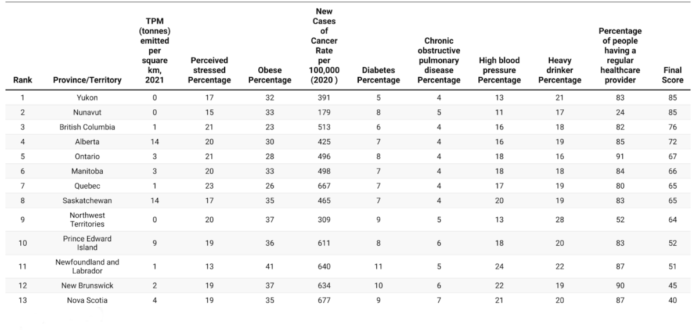From a release sent to us:
YUKON/N.S.: A recent study by Canadian health experts at lighthousedentalcentre.com found that Yukon is the healthiest province in Canada. They scored an impressive 85.
On the other hand, Nova Scotia and New Brunswick are the least healthy, with final scores of 40 and 44.7, respectively.
In this study, the health landscape across all 13 of Canada’s provinces, using a multifaceted approach that incorporated emissions per square kilometer, obesity rates, stress levels, and the prevalence of various chronic health conditions such as diabetes, COPD, and high blood pressure.
ADVERTISEMENT:
The study also examined lifestyle choices like smoking and heavy drinking, as well as the availability of healthcare, indicated by the percentage of residents with a regular healthcare provider.
Utilizing 13 distinct criteria, each region received a score out of 100, which were then aggregated and weighted to produce a final comprehensive health score.
The data is taken from The official website of the Government of Canada of the latest year.
The final composite score, ranging from 40 to 85 (to provide a more easily interpretable assessment), offers a statistically meaningful evaluation of the overall performance of each province and territory.
ADVERTISEMENT:
Key findings:
- High Environmental Impact: Alberta and Saskatchewan have notably high levels of TPM emitted per square km, indicating significant environmental stress in these regions.
- Elevated Stress and Mood Disorders: Quebec has the highest percentage of perceived stress, while Nova Scotia reports the highest percentage of mood disorders. These could be important indicators for mental health services.
- Highest and Lowest Obesity Rates: Newfoundland and Labrador have the highest obesity rates at 40.9%, which could be a public health concern. On the other hand, British Columbia has the lowest at 22.9%.
- Smoking Prevalence: Nunavut has an alarmingly high daily smoker percentage at 46.8%, far above any other region. This could be a significant public health issue.
- Access to Healthcare: Ontario has the highest percentage of people with a regular healthcare provider at 90.6%, suggesting better healthcare accessibility. In contrast, Nunavut has only 23.6%, indicating a potential gap in healthcare services.
- Cancer Incidence: Quebec has the highest rate of new cancer cases per 100,000 people, which might indicate a need for increased cancer prevention and treatment services in the province.
- ADVERTISEMENT:
- Yukon
- The Yukon has the lowest amount of emissions per square km at just 0.15 tonnes. The population is moderately stressed, with 16.5% reporting stress. Obesity rates are high at 31.9%. New cases of cancer are also significant at 391.3 per 100,000 people. However, the percentages for chronic conditions like diabetes, COPD, and high blood pressure are relatively low. It also has the lowest daily smoker percentage at 10.5%, but 20.7% are heavy drinkers. About 83% of people have a regular healthcare provider. The overall health index for the territory is 85.
- Nunavut
- Nunavut has very low emissions at 0.03 tonnes per square km and a slightly lower perceived stress percentage at 15.4%. Obesity rates are high at 33.1%. New cancer cases are much lower than other areas at 178.8 per 100,000 people. Smoking is a significant issue, with 46.8% of the population being daily smokers. Only 23.6% have a regular healthcare provider. Its final health score is 84.8.
- British Columbia
- British Columbia has moderate emissions per square km at 1.17 tonnes. Around 20.6% of its population reports being stressed. It has one of the lowest obesity rates at 22.9%. It also has a high cancer rate at 513 cases per 100,000 people. However, its final score is 75.5, which is relatively better compared to many provinces.
- ADVERTISEMENT:
- Alberta
- Alberta has a very high emission rate at 14.15 tonnes per square km. About 20.1% of the population perceives themselves as stressed, and 29.5% are obese. The cancer rate is 425.4 per 100,000 people. Its final health score is 71.5.
- Ontario
- Ontario has emissions of 2.7 tonnes per square km. It has a high level of perceived stress at 20.9% and an obesity rate of 28.1%. It also has a high rate of new cancer cases at 496.3 per 100,000. Its final health score is 67.4.
- Manitoba
- Manitoba has an emission rate of 3.14 tonnes per square km. Around 20% of the population is stressed, and the obesity rate is 32.6%. It has a relatively high rate of new cancer cases at 497.9 per 100,000. The final health score is 66.
- Quebec
- Quebec has low emissions at 0.94 tonnes per square km but has the highest stress levels at 22.7%. Obesity rates are moderate at 25.9%, but it has the highest cancer rate at 667.4 per 100,000. The final health score is 65.4.
- Saskatchewan
- Saskatchewan has high emissions at 13.77 tonnes per square km. The obesity rate is also high at 35.3%, and it has 464.6 new cancer cases per 100,000 people. Its final health score is 64.8.
- ADVERTISEMENT:
- Northwest Territories
- Northwest Territories have low emissions at 0.05 tonnes per square km but have the highest obesity rate at 37.1%. Smoking and heavy drinking are also significant issues. The final health score is 63.5.
- Prince Edward Island
- PEI has an emission rate of 8.78 tonnes per square km. It has an obesity rate of 36.2% and a high cancer rate of 610.6 per 100,000 people. Its final health score is 52.4.
- Newfoundland and Labrador
- This province has low emissions at 0.54 tonnes per square km but has the highest obesity rate at 40.9%. The cancer rate is also high at 639.7 per 100,000 people. Its final health score is 51.3.
- New Brunswick
- New Brunswick has an emission rate of 2.33 tonnes per square km and a high obesity rate of 37.4%. The province has a high cancer rate at 633.5 per 100,000 people. The final health score is 44.7.
- Nova Scotia
- Nova Scotia has an emission rate of 4.4 tonnes per square km. The province has an obesity rate of 34.7% and the highest cancer rate at 676.7 per 100,000 people. It also has the highest percentages of diabetes and COPD. Its final health score is 40.





















